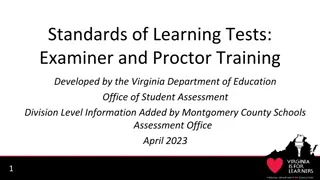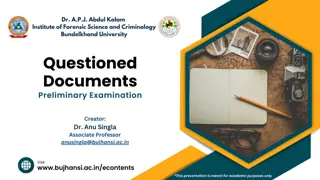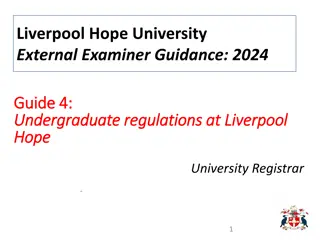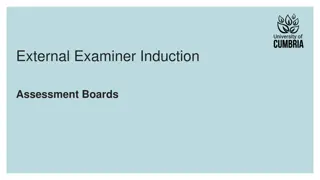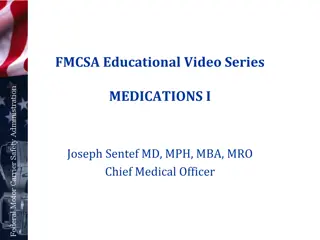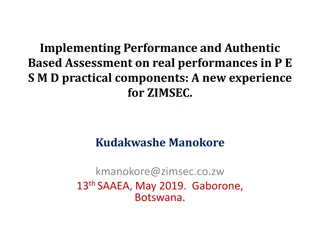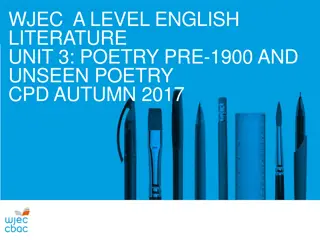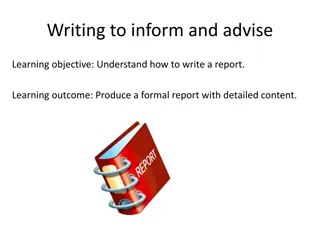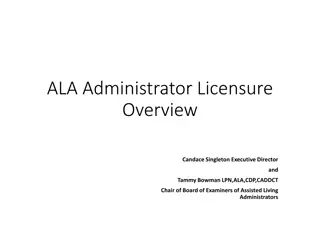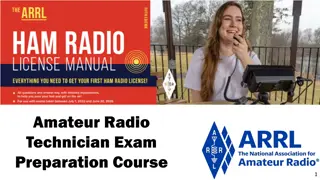
Engaging Psychology Teachers: Insights from 2016 Exams
Gain valuable insights from the May 2016 psychology exams focusing on teaching strategies, exam performance analysis, and key areas for improvement in approaching Paper 1 and Paper 2. Discover where students struggled, what to emphasize in teaching, and the significance of essay questions for overall grades.
Uploaded on | 0 Views
Download Presentation

Please find below an Image/Link to download the presentation.
The content on the website is provided AS IS for your information and personal use only. It may not be sold, licensed, or shared on other websites without obtaining consent from the author. If you encounter any issues during the download, it is possible that the publisher has removed the file from their server.
You are allowed to download the files provided on this website for personal or commercial use, subject to the condition that they are used lawfully. All files are the property of their respective owners.
The content on the website is provided AS IS for your information and personal use only. It may not be sold, licensed, or shared on other websites without obtaining consent from the author.
E N D
Presentation Transcript
Webinars What The Examiner Said - And How to Respond for Summer 2017 Sunday 11thSeptember @ 8:30 Energising Students in the Year 1 Psychology Classroom Thursday 15thSeptember @ 8:00 Practical Approaches to Teach Issues and Debates in Year 2 Psychology Sunday 18thSeptember @ 8:00 Fast-Track Your Planning for AQA A Level Psychology (Year 2) 23rd September Birmingham 30th September London
Session Aims An Overview of the May 2016 Exams What can we learn from this year s AS results? Where should we focus our teaching this year? What can we learn from Paper 1? Beyond the extract Know the specification Research=Theories/Studies Quote the extract/STEM Signposting What can we learn from Paper 2? Approaches are separate! Hypothesising! Use ALL of the data In this study How this study
An Overview of the May 2016 Exams An Overview of the May 2016 Exams What can we learn from this year s AS results? Where should we focus our teaching this year?
Paper 2 Paper 1 AQA% Average % AQA% 73 23 69 56 49 91 46 91 66 42 51 61 27 51 38 55 56 68 63 Average % Approaches & A1.1 AO1-3 A1.2 AO2-3 A2.1 AO2-1 (MCQ) A2.2 AO2-2 A2.3 AO3-4 A3 AO1-3 A4 AO1-4, AO3-4 B5 AO1-4 B6 AO2-6 B7 AO3-2 B8 AO1-6, AO3-6 C9 AO3-2 C10.1 AO1-2 C10.2 AO1-2 C11 AO2-6 C12 AO1-6, AO3-6 83 44 70 94 92 38 63 59 80 92 41 71 96 96 53 51 A1 A2 A3 A4 A5 B6 B7 B8 B9 B10 C11.1 AO2-2 C11.2 AO2-3 C11.3 AO2-3 C11.4 AO3-3 C11.5 AO3-4 C11.6 AO2-2, AO3-2 C11.7 AO2-1 C11.8 AO2-2 C11.9 AO3-3 AO3-2 AO1-2 AO1-4 AO2-6 AO2-4 AO1-4, AO3-4 AO1-3 AO1-4 AO3-1 AO2-4 AO1-6, AO2-2, AO3-4 Biopsych 54 Social 69 Psychopatholo gy 67 Memory 68 Attachment 73 RM 52 70 AO1=14 AO2=18 AO3=8 74 68 85 58 AO1=13 AO2=27 AO3=12 58 57 60 Essays=32 52 Essays=20 42
An Overview Students performed significantly worse on Paper 2 in comparison to Paper 1. Approaches & Biopsychology and RM were two the worst areas. Next year RM is worth more than any other topic (48 marks instead of 24)! Biopsychology becomes its own section (worth 24 marks) Essay questions posed a real problem in both papers, with an average percentage of 52% (Paper 1) and 42% (Paper 2). This is rather alarming as essays were worth 36.11% of the overall grade! AO2 was the weakest assessment objective in both papers.
An Overview of the May 2016 Exams An Overview of the May 2016 Exams What can we learn from this year s AS results? Where should we focus our teaching this year? Any questions?
What can we learn from Paper 1? What can we learn from Paper 1? Beyond the extract Know the specification Research=Theories/Studies Quote the extract/STEM Signposting
AO2 = 3 Marks 44% Average 2.1 Beyond the Extract 01.2 Marcus wants to persuade his group of friends to go travelling in the summer, but the rest of the group would like to go on a beach holiday. Briefly suggest how Marcus might use the three behaviours that you have identified in your answer to 01.1 to persuade his friends to go travelling. Commitment Flexibility Consistency
AO2 = 3 Marks 44% Average 2.1 Beyond the Extract Many students typically stated that Marcus should show consistency by being consistent in his point of view. Some students offered implausible and probably ineffective suggestions, for example, that Marcus could go on hunger strike or refuse to speak to his friends Better responses explained that Marcus would repeat to his friends over and over how good it would be to go travelling.
AO2 = 3 Marks 44% Average 2.1 Beyond the Extract Suggested Answer: Marcus would need to be stable in his view (consistent), that going travelling in the summer is better than going on a beach holiday and continually remind his friend of this. Furthermore, Marcus should be prepared to compromise (flexible) for example, he might say that if his friends go travelling, they could also visit a beach to demonstrate his willingness to compromise. Teaching Idea: Why not show your students a poorly applied example: e.g. Marcus could show consistency by being consistent and could show commitment by going on a hunger strike to get his own way Then ask your students to improve these answers Teaching Idea 2: Role Play the scenarios.
AO1 = 3 Marks 38% Average 2.2 Know the Specification 03 The study in question 02 involves a self-report. Outline what is involved in self-report [3 marks]. This question was generally quite poorly answered many confused self-report with peer review or report writing. A number of students offered pre-learned evaluative points that did not gain credit.
AO1 = 3 Marks 38% Average 2.2 Know the Specification
AO1/3 = 12 Marks 41% Average 2.3 Research = Theories/Studies 08 Discuss what psychological research has shown about working memory. In your answer, refer to theory and/or evidence. [12 marks] Research = Theories/Studies Hasshow = Results Whilst it was quite legitimate to focus on studies of working memory, with credit awarded for what the research has shown , it was most appropriate to focus on the findings/conclusions rather than on elaborate detail of the method
AO2 = 6 Marks 53% Average 2.4 Quote the Extract/STEM 11 Abi had a happy, secure childhood with parents who loved her very much. She now has two children of her own and loves them very much too. The two children make friends easily and are confident and trusting. Referring to Abi and her family, explain what psychologists have discovered about the internal working model. [6 marks] 1. What have psychologists discovered about the internal working model 1. Referring to Abi 2. Referring to her family
AO2 = 6 Marks 53% Average 2.4 Quote the Extract/STEM Largely ineffective responses included little psychological content. There were vague anecdotal suggestions about past experience or growing up in a happy family.
AO2 = 6 Marks 53% Average 2.4 Quote the Extract/STEM Suggested Answer: Bowlby believed that children develop an internal working model from their monotropic attachment. According to Bowlby this is usually the mother or a mother- substitute. This internal working model is a mental representation which acts a template for future relationship. Evidence to support the internal working model comes from Hazan and Shaver, who used a questionnaire called the Love Quiz. They found a positive correlation between early childhood experiences and later love experiences. Securely attached children went on to develop secure and happy adult relationships. This supports Bowlby s idea of an internal working model as it clearly shows that early attachment experiences can affect later adult relationships, through the internal working model. As Abi had a secure childhood with parents who loved her very much this would have led to her developing a positive internal working model, allowing her to go onto form secure attachments with her children who she loves very much , as suggested by Hazan and Shaver. Furthermore, her children who are also securely attached have gone onto make secure attachments with their friends, as they are confident and trusting in their relationships. [186 words]
AO2 = 6 Marks 53% Average 2.4 Quote the Extract/STEM 11 Abi had a happy, secure childhood with parents who loved her very much. She now has two children of her own and loves them very much too. The two children make friends easily and are confident and trusting. Referring to Abi and her family, explain what psychologists have discovered about the internal working model. [6 marks] Example Paragraph: As Abi had a secure childhood with parents who loved her very much this would have led to her developing a positive internal working model, allowing her to go onto form secure attachments with her children who she loves very much , as suggested by Hazan and Shaver. Furthermore, her children who are also securely attached have gone onto make secure attachments with their friends, as they are confident and trusting in their relationships.
AO1/3 = 12 Marks 51% Average 2.5 Signposting 12 Discuss the Strange Situation as a way of assessing types of attachment. [12 marks]. The majority of discussions were pre-prepared Describe and evaluate the Strange Situation answers, whilst more successful answers explicitly addressed the matter of the appropriateness or usefulness of the procedure for measuring type of attachment.
AO1/3 = 12 Marks 51% Average 2.5 Signposting Point: One problem with the strange situation is that the observation was an overt observation, as the mothers new they were being watched. Point Evidence / Evidence: As a result, there may have been demand characteristics where the mothers changed their behaviour to appear like excellent parents. Example This matters because this could affect the child s behaviour which would then effect the results of the experiment, making the results less valid. Explain
AO1/3 = 12 Marks 51% Average 2.5 Signposting There are several issues with using the Strange Situation as a method of assessing attachment Point: For example, one problem with the strange situation is that the observation was an overt observation, as the mothers new they were being watched. Point Evidence / Evidence: As a result, there may have been demand characteristics where the mothers changed their behaviour to appear like excellent parents. Example This matters because this could affect the child s behaviour which would then effect the results of the experiment, as the researchers would not be observing the child s natural behaviour, which could make the Strange Situation a less valid measure of attachment. Explain
What can we learn from Paper 1? What can we learn from Paper 1? Beyond the extract Know the specification Research=Theories/Studies Quote the extract/STEM Signposting Any questions?
What can we learn from Paper 2? What can we learn from Paper 2? Approaches are separate! Use ALL of the data In this study How this study
AO1/3 = 8 Marks 49% Average 3.1 Approaches are Separate 05 Outline two features of the cognitive approach. Explain two limitations of the cognitive approach. [8 marks] There are no absolutes in psychology. Some students misread the question and produced answers that focused on the cognitive approach to depression. The cognitive approach overemphasises the role of cognition and is limited in taking into account biological explanations . There were also a number of attempts at limitations which were too extreme in their assertion such as, cognitive psychology ignores emotion, ignores biology and ignores culture or only uses experiments.
AO1/3 = 8 Marks 49% Average 3.1 Approaches are Separate A significant number of responses, for example, seemed to suggest schemas lead to stereotypes and therefore this limits the cognitive approach because stereotyping is a bad thing. Understanding that people are cognitive misers is a useful piece of information, as such awareness might in fact help us to deal with stereotyping in society. 1. 2. 3. Approaches are separate to psychopathology The Cognitive Approach doesn t ignore biology, it just overemphasises the importance of cognition Understanding the importance of schemes in relation to stereotyping is a strength
Research Methods 11 A researcher wanted to compare the effectiveness of two therapies for young offenders who had been identified as having anger management issues. Offenders, who were all sentenced to two years in a Young Offenders Institution, were asked to volunteer to take part in an anger management programme. Fifty volunteers were randomly allocated to Group 1 (Therapy A) or Group 2 (Therapy B). Each participant s anger was assessed before and after therapy. For the pre-therapy anger score they completed an Anger Scale questionnaire and their responses were scores. A high score indicated extreme anger and a low score indicated mild anger. The data obtained are shown in Figure 1 below.
Research Methods 60 50 Median anger scores 40 30 Pre-therapy anger score Post-therapy anger score 20 10 0 Group 1 (Therapy A) Group 2 (Therapy B)
AO2 = 2 Marks 51% Average 3.2 In This Study 11.1 The researcher used volunteers for this study. Outline one disadvantage of using volunteers to take part in this study. [2 marks] One problem with a volunteer sampling is that the sample might be biased. In this study, possibly the eager Young Offenders would be willing to volunteer and they would not represent all of the Young Offenders. these eager young offenders may be more responsive treatment which would further bias the results. For full credit students needed to apply their knowledge of a problem associated with volunteers in this particular study. Many only referred to bias or representativeness and did not relate their responses to type of offender/ possible effect on therapy or on anger scores. Furthermore, to the
AO3 = 4 Marks 38% Average 3.2 How this study 11.5 Explain how the study might be improved by using a matched pairs design. [4 marks] In order to use match pairs, the participants would be matched on a key variable, for example pre-anger score and then from each pair, one person would be placed in Group 1 and the other in Group 2. This would reduce the chance of participant variable, as both groups would have participants who are matched in terms of their initial anger. These students resorted to explaining matched pairs in a generic way without reference to the criteria which could be used for matching. Instead they often suggested IQ, age and sex as the crucial points, rather than pre-therapy anger scores.
AO2/3 = 4 Marks 55% Average 3.2 In This Study 11.6 Outline one ethical issue that might have occurred in this study and explain how the researcher could have dealt with this issue. [4 marks] ER: It was surprising that a number of students missed the second part of this question. One ethical issue that might have occurred in this study is protection from harm, as the Young Offenders may have felt anxious while receiving treatment. This could be dealt with by giving the participants the right to withdraw from the therapy and debriefing the participants to offer them any follow-up care, if required. They could also be provided with a chance to ask any questions about the study.
AO3 = 3 Marks 55% Average 3.3 Use ALL of the Data 11.4 What does the data in Figure 1 seem to suggest. [3 marks] Many students failed to write enough about the data often just referring to the greater reduction in Group 2/Therapy B indicating that it was more effective. There were many points that could have been extrapolated from the data in Figure 1.
AO3 = 3 Marks 55% Average 3.3 Use ALL of the Data 60 Teaching Idea: Print of Sample Paper Graphs on A3 Paper and get your students to what the data shows . 2. Group 1 were more angry to begin with. 50 1. Both therapies are effect. Median anger scores annotate 40 3. Group 1 were more angry at the end of the experiment 30 Pre-therapy anger score Post-therapy anger score 20 10 4. The improvement in group 2 was a decrease of 25 compared to 20 in group 1 and was therefore slightly more effective. 0 Group 1 (Therapy A) Group 2 (Therapy B)
What can we learn from Paper 2? What can we learn from Paper 2? Approaches are separate! Hypothesising! Use ALL of the data In this study How this study Any questions?
Todays Resources & Any Questions Today s resources will be posted in our AQA Teacher FB Group. Search AQA A Level Psychology Teachers https://www.facebook.com/gro ups/aqaalevelsociologyteachers / OR Sign Up to our Daily Digest: http://www.tutor2u.net/dailydi gest and receive an email tomorrow morning directing you to the resources.
Whats Next? How to respond 1. Analyse your own results 2. Dedicate more time to RM/Approaches & Biopsych 3. Dedicate more time to essay writing http://www.tutor2u.net/psychology/series/teaching-exam-technique- essay-writing-skills Paper 2 Paper 1 AQA% Average % AQA% 73 23 69 56 49 91 46 91 66 42 51 61 27 51 38 55 56 68 63 Average % Approaches & A1.1 AO1-3 A1.2 AO2-3 A2.1 AO2-1 (MCQ) A2.2 AO2-2 A2.3 AO3-4 A3 AO1-3 A4 AO1-4, AO3-4 B5 AO1-4 B6 AO2-6 B7 AO3-2 B8 AO1-6, AO3-6 C9 AO3-2 C10.1 AO1-2 C10.2 AO1-2 C11 AO2-6 C12 AO1-6, AO3-6 83 44 70 94 92 38 63 59 80 92 41 71 96 96 53 51 A1 A2 A3 A4 A5 B6 B7 B8 B9 B10 C11.1 AO2-2 C11.2 AO2-3 C11.3 AO2-3 C11.4 AO3-3 C11.5 AO3-4 C11.6 AO2-2, AO3-2 C11.7 AO2-1 C11.8 AO2-2 C11.9 AO3-2 AO1-2 AO1-4 AO2-6 AO2-4 AO1-4, AO3-4 AO1-3 AO1-4 AO3-1 AO2-4 AO1-6, AO2-2, AO3-4 Biopsych 54 Social 69 Psychopatholo gy 67 Memory 68 Attachment 73 RM 52 70 AO1=14 AO2=18 AO3=8 74 68 85 58 AO1=13 AO2=27 AO3=12 58 57 60 Essays=32 52 Essays=20 42
Dont forget to sign up for our future webinars: www.tutor2u.net/psychology/events Please follow us on Twitter @tutor2upsych and spread the word Join our Teacher FB Community, search: AQA A Level Psychology Teachers Encourage your students to join our Student FB Community: A Level Psychology Student Group . If you ever need any advice, support or guidance, email: joseph@tutor2u.net Any Questions?



